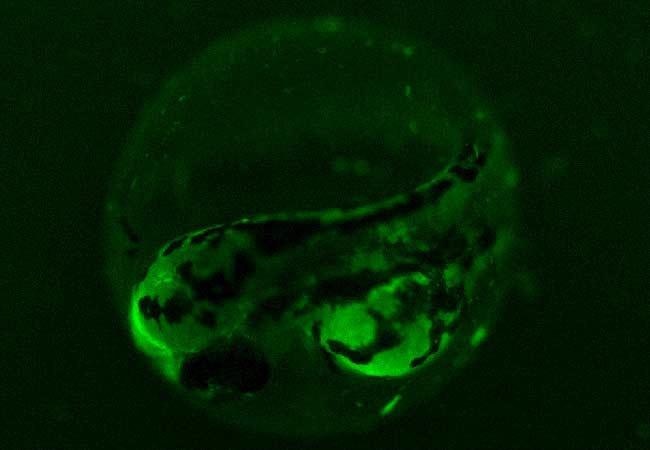With the early evaluation of recently formulated sustainable products and chemicals, there is a possibility to evaluate the possible risk of hazardous substances being released in product cascades at a later point. This has been demonstrated in a proof-of-concept study coordinated by Goethe University Frankfurt and RWTH Aachen University.
 Zebra fish eggs indicate for ecotoxicity to already reduce environmental burden during product development. Image Credit: Henner Hollert Lab.
Zebra fish eggs indicate for ecotoxicity to already reduce environmental burden during product development. Image Credit: Henner Hollert Lab.
In this study, the toxicity sustainable biosurfactants, which are used in, for example, bio-shampoos, and as a new approach for the economical application of plant protection agents — were examined with a combination of computer modeling and laboratory experiments.
This research is the first step towards a safe bioeconomy, from an eco-toxicological standpoint and from those using sustainable processes and resources to considerably decrease environmental burdens.
Although earth’s natural resources are short in supply, they are also the basis for human prosperity and development. This is a dilemma that the EU aims to overcome with the help of its revised bioeconomy strategy. The strategy puts forth that the economy should be based on renewable materials, such as microorganisms, plants, wood and algae, instead of fossil-based materials.
Everything has to be found in closed loops at some point in time; however, the execution of a circular bioeconomy needs a change in the production of chemicals. These also need to be made from bio-materials, instead of crude oil.
Based on these requirements, in 1998, the American chemists, Paul Anastas and John C. Warner formulated twelve principles of green chemistry. One of their principles is “the reduction of the environmental toxicity of newly developed substances.” However, this principle has been much neglected until now.
This is where the interdisciplinary project “GreenToxiConomy” — a part of the scientific alliance Bioeconomy Science Center (BioSC) — comes into play.
The aim was to analyze bio-based substances and advanced technologies to study their hazardous impact on the environment at an initial stage of product development and to incorporate the results into the design of the product.
Project partners from Aachen, Jülich, and Düsseldorf offered two of their bio-based product agents for the examination, which are biosurfactants and microgel containers for crop protection agents.
The wash-active biosurfactants that are used in detergents and shampoos at BioSC depend on the synthesis capacities of the bacterium Pseudomonas putida and the fungus Ustilago maydis, respectively, instead of crude oil.
As the containers make sure that the active ingredients stick to the plants even during the rain, the microgel technology enables the controlled delivery of crop protection agents.
For the analysis of novel substances and technologies we have selected a broad range of concentration to be able to adequately estimate potential hazards for humans and the environment. We wanted to examine whether the bio-based surfactants were more environmentally friendly than conventional chemical surfactants. In addition, we investigated whether the microgel containers per se induce any toxicity.
Dr. Sarah Johann, Study Lead Author, Institute for Ecology, Evolution and Diversity, Goethe University Frankfurt
Dr. Sarah is also the head of a working group at the Department of Evolutionary Ecology and Environmental Toxicology.
To confirm the ecotoxicological assessment was as accurate as possible, the research team integrated two elements in the toxicity determination: experiments in the laboratory (in vitro and in vivo) and computer-aided prognoses (in silico). The computer models function with the toxicity data of known chemicals. To predict the toxicity, the structure of known chemicals is compared with the structure of the new bio-based substances.
The experiments were performed on terrestrial and aquatic organisms that represent certain organism groups, which include springtails, earthworms, water fleas and zebra fish embryos at a very initial phase.
The result achieved shows that both biosurfactants and microgels are extremely likely candidates for utilization in a future bioeconomy whose products need to be sustainably produced, without causing any damage to the environment or harm to humans at both utilization and after utilization stages.
We can only make statements within certain limits, however, as the transfer of laboratory results to the reality in the open field or in other applications is complicated.
Dr. Sarah Johann, Study Lead Author, Institute for Ecology, Evolution and Diversity, Goethe University Frankfurt
More studies are required for a complete evaluation of the risk potential; hence, follow-up projects are intended.
Prof. Henner Hollert, head of the evolutionary ecology and environmental toxicology department at Goethe University Frankfurt, highlights the importance of the close interdisciplinary collaboration on “GreenToxiConomy”.
In the research, biotechnologists and engineers together devised a new product, and it was assessed at the development stages by eco-toxicologists from Goethe University along with a team at RWTH Aachen led by Prof. Dr. Martina Roß-Nickoll.
“This continuous process is the major strength of the project.” According to Hollert, it is already evident that eco-toxicology and green toxicology will play a significant role in the plans being formulated by the EU, even though it is just a first step towards a bioeconomy that is safe in terms of eco-toxicology.
Whenever it is a question of future bio-based product development and product design, we have to clarify the consequences for humans and the environment at an early stage. In this respect our approach can provide valuable results.
Henner Hollert, Professor and Head, Evolutionary Ecology and Environmental Toxicology Department, Goethe University Frankfurt
Journal Reference:
Johann, S., et al. (2022) A plea for the integration of Green Toxicology in sustainable bioeconomy strategies – Biosurfactants and microgel-based pesticide release systems as examples. Journal of Hazardous Materials, 426. doi.org/10.1016/j.jhazmat.2021.127800.